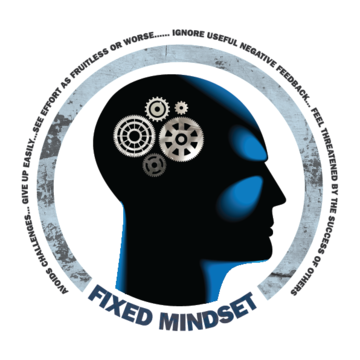The Struggling Student: Why Do Some Students Simply Give Up?
So what’s the difference? Why is it that some students simply give up (and apparently so easily), while others persist even when it requires hard work and effort? And more importantly, what do we do about it?
Why Do Some Students Simply Give Up?
When we’re faced with these students, it’s easy to draw conclusions. It’s a simple solution to believe that they’re just lazy (and human nature to draw that quick conclusion). But actually that’s probably not the case.
In fact, BOTH students are likely acting entirely reasonably – at least from their point of view. It’s just that their points of view, their mindsets, are entirely different.
The Growth Mindset - Persistence makes sense

The more persistent student has a different way of viewing the problem they are tackling, and academics and learning generally. To put it simply – they expect their effort to pay off. They believe that the hard work they’re putting in now will bring them a return. And they know that the struggle they are experiencing today is temporary, and that because of their hard work, that it will be easy (or easier) for them tomorrow.
This is a growth mindset.
The Fixed Mindset - Giving up makes sense
On the other hand, the student who gives up easily doesn’t expect anything to change. Things that are hard today, will be hard tomorrow. Worse, they believe the next step is going to be harder, and the one after that harder again! From that point of view, there’s no point in persisting because down that path just lies more struggle and eventual failure. For this student, with a Fixed Mindset, their life becomes about the path of least resistance.
From that student’s point of view there’s simply no point in persisting. They believe that down that path just lies more and more struggle which will eventually end in failure. So it just makes sense to give up. And instead of struggling for what they believe will be no reward, they seek out the path of least resistance.
This is a fixed mindset.
So how do we change this student’s fixed view of their abilities? How do we help them want to keep trying, and believe in the eventual reward that will come from hard work and persistence?
Fixing a Fixed Mindset – Learning About Their Learning Zone
Our goal in my Growth Mindset Masterclasses, is to do just that – to help students develop a more growth-oriented mindset. One of the strategies that we explore is teaching students to recognise their learning zone.
Your learning zone is that level of challenge that is just beyond your current best. It’s that bit of stretch that’s sometimes referred to as your ‘zone of proximal development'.
The thing about moving into your learning zone is that it feels uncomfortable. That’s because the solution to the problem you’re working on is not immediately apparent, so you feel uncertain. And it feels this way for everyone!
Compare this to how it feels to be in your comfort zone. Here you feel sure and confident. The solution to the problem you’re working on is immediately apparent. You’re the expert. You have the knowledge or experience. And you know that you just need to spend the time and you can be sure of success.
Students with fixed mindsets flee the discomfort and uncertainty of their learning zone for the comfort and certainty of their comfort zone. Students with a fixed mindset don’t realise that those students who persist and struggle are still feeling discomfort and uncertainty. They’re still unsure about the answer or whether or not they will succeed in the end. They just understand that the feeling is temporary and that it’s the price that has to be paid to achieve the growth.
As teachers, we help develop a growth mindset in all our students when we identify the times when students are expected to be in their learning zone, and when they aren’t. Eduardo Briceño explores this idea beautifully in his TED Talk, ‘How to get good at things you care about’.
As educators we encourage a growth mindset when we make struggle part of our classrooms. We expect it and value it in ALL students whenever they are in their learning zone. We don’t make effort a ‘necessary evil’ that’s only required if you can’t do it easily. We make it an integral part of the learning experience.
Becoming "comfortably uncomfortable" in your Learning Zone and recognising struggle as the cost of growth are just two strategies that help encourage your students to develop a Growth Mindset. When these and other similar messages are reinforced, day after day, students begin to embrace challenges as learning opportunities. They begin to believe that they will become better at tasks if they just put in the right sort of effort. And students who once took the easy path begin a journey of ongoing challenge and growth.
Best Wishes,
Stay connected with news and updates!
Join my mailing list to receive the latest news and updates about mindset, Habits of Mind, Learning Agility and more.
